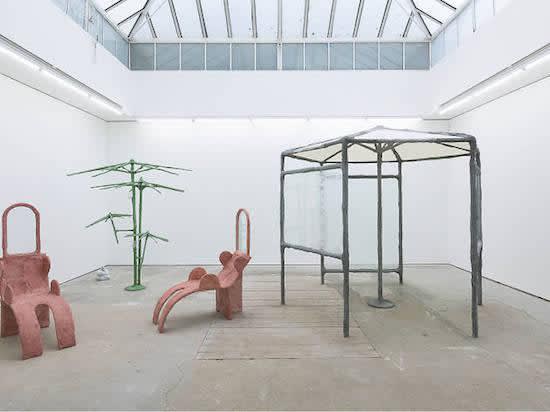06 July 2018 The Israeli artist Oren Pinhassi has created sculptures around the world. Whenever he has an exhibition abroad, he doesn’t ship pieces from his studio in East Harlem. Instead, he goes to the country of the exhibition and spends a chunk of time toiling away in the new environment, forming and moulding each and every piece anew. It’s his way of grounding his pieces in their geographical context and exploring the ways in the local environment shapes the way he works.

Oren Pinhassi, Second Nature, installation view, Edel Assanti, London, UK, 2018
For his latest show, at Edel Assanti gallery in London’s Fitzrovia, he spent a month in Suffolk creating objects that appear to be familiar archetypes – a palm tree, a chair, or a towel, for example. However, a moment’s concentration transforms them into something completely different. One realises that the palm tree is actually made from steel umbrellas of varying sizes, stacked in a blooming formation; the chair resembles a reclining woman with protruding, misshapen breasts; the towel is grotesquely coiled like a snake. It is this ambiguity and perpetual sense of becoming that Pinhassi exploits, as suggested by the exhibition’s title, ‘Second Nature’.
There’s a palpable erotic energy, with a pair of glass-fronted urinals facing each other, and the palm tree pieces suggestively titled ‘One in the mouth and one in the heart’. A pair of freestanding pavilions, meanwhile are partially lined with glass panels that have been meticulously smeared with swirls of Vaseline, walking a fine line between privacy and voyeurism. Pinhassi embraces the sexual element of his work, though he insists that its ‘queerness’ comes not from these connotations alone. Rather, he stands for a rejection of traditional boundaries: in architecture, in nature, and in the body.
‘I seek to break down binary categories,’ he declares. Interestingly, much of his earlier work featured ‘a lot of wood, and right angles’ – and it was a frustration with the rigidity of the material that drove him to explore the shapeshifting potential of plaster, sand and burlap, which feature prominently in this exhibition.
While there are readymade elements in Pinhassi’s work – the skeletal structures of children’s umbrellas, for instance are used to form the palm trees – there is also ample evidence of the human hand on their primordially rugged surfaces. He calls his sculpting process one of ‘repetitive touch’ – working away at the plaster with his hands a little at a time – no two objects he creates are ever exactly the same. It is this dance between familiarity and ambiguity that informs Pinhassi’s artisanal approach.
Within the ground-level space of the gallery, Pinhassi’s sculptures are carefully placed to guide viewers through a ‘forest’ of nebulous forms. Ultimately, it’s the visitor’s reac


